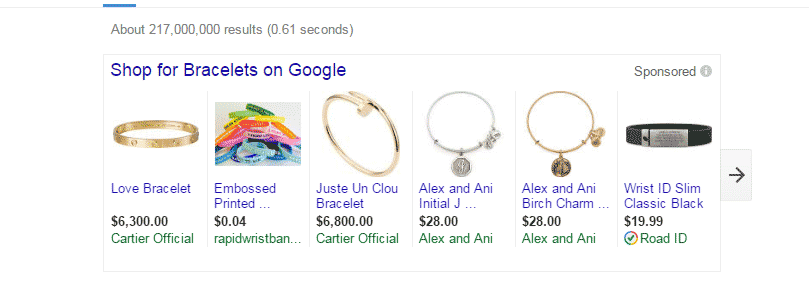Google is one of the most popular sites where shoppers are searching for products, whether it is on smartphones, tablets or desktops. In fact, merchants should use Google product listing ads (PLAs) to further build brand awareness and show customers products they may not have found elsewhere.
Product listing ads are an important part to the overall shopping experience. Product listing ads provide retailers another opportunity to get in front of the customer when they’re searching for a specific product.
Link Walls, Vice President of Product Management of ChannelAdvisor, said Google product listing ads feature a single product showing product information such as an image, price, title as part of an ad. These ads typically display in an ad unit of six to eight product listing ads on a Google search results page.
“Over the last three years, Google has directed more and more traffic to this format given the positive response consumers have shown,” said Walls. “Putting a product image in front of the consumer rather than just text drives a greater level of engagement with the ad and ultimately more clicks.”
In May, product listing ads were added to image search as part of the Google search network. However, most digital marketers are having a hard time determining the best strategy for their products. Product listing ads are growing in popularity, making Google the channel of choice for retailers and brands to reach consumers across any device.
Google also provided a “with special offers” filter option that appears in a product card unit. For single product listing ads link to a landing page on Google Shopping that is formatted like an expanded version of a typical product card unit.
Earlier this month, Google made a change to where its product listing ads are showing up at the top of the search results in a carousel format for desktop. This is being made possible in the U.S. and is expected to go international as well.
The SEM Post reported that Google is showing a carousel at the top is “pretty significant” for searchers, advertisers and SEO. It offers a change from the four to five non-scrolling ad units that are normally shown.
Walls said in during the Multichannel Merchant webinar, Google Your Way to Better Digital Marketing Campaigns, that Google is great at having ads that are relevant and engaging to consumers, it’s pretty clear that consumers have spoken when they are looking and searching for products that they are going straight to the image of the products.
“Showing the products rather than text ads is a user experience that is winning out in a pretty big way,” said Walls.
Earlier this year, Google dropped the right rail for text ads. Part of this move was the growth in mobile. Walls said Google is trying to come up with a more consistent user experience whether you are on a mobile or desktop.
“Mobile growth is driving a lot of changes in ways that were somewhat unthinkable a couple of years ago,” said Walls. “The search results page really changed quite a bit.”
The Importance of PLAs
Walls said product listing ads are important because they represent the fast-growing ad format for retailers. Getting access to qualified traffic at an acceptable cost per click is the challenge for every online marketer and product listing ads have proven to be very effective in that regard.
“A significant number of consumers start their search for a product on Google and PLAs are quite often the ad format they are choosing to engage with,” said Walls. “In fact, across ChannelAdvisor customers we often see that upwards of 70% of non-brand searches are in a PLA click with the remaining 30% going to a text ad.”
Walls said retailers benefit from product listing ads because they have proven to generate significant amounts of qualified traffic at reasonable costs. This results in an overall very positive return on investment for the retailer.
“Nearly all medium to large retailers are using PLAs,” said Walls. “The one notable exception is Amazon which does not participate.”
Last Autumn, AdGooRoo reported that Party City saw an increase in product listing ads performance when it came to its Halloween costume keyword group, going from 4.6% PLA click share in August and September to 17.8% click share from October 1 through 23.
Target also saw an increase in PLA click share last year on the keyword group, going from 12.9% in August and September to 16.5%, October 1 through 23.
PLAs and the Holiday Season
Walls said retailers need to make sure their campaigns are in good shape for surge of holiday traffic. Some key items to focus on are making sure that the retailer is using Google Merchant Promotions to reflect their promotions on Google.
Additionally, Walls said, make sure that all products are live, up to date and complete. Information in Google Merchant Center is a good best practice going into the holiday season.
Walls also added that as merchants come up on holiday, make sure budgets are adequate for product listing ads to the extent those are performing well, and you want to make sure that with the growth of product listing ads that you aren’t caught in a situation at holiday that your budgets are capped and you are maxing out where you could be spending more at a profitable ROI.
In a survey by Kenshoo, this holiday season, holiday marketing programs go to Google. Seventy-four percent of those surveyed said search keyword ads were very important to holiday marketing, and product listing ads were cited as important by 61% of respondents.
The survey revealed that Google gets the majority of the money when it comes to spend on search. Google takes up 68% of the spend, and 62% of the companies said this is an increase over the last year. Of the companies surveyed, 9% said they are increasing their year-over-year spend on Google.
Trends with Google PLAs
Walls said that search advertising has shifted from “ten blue links to rich product ads because of superior customer experience.”
“If you go back a little over a year ago or year and a half ago, the mix of text ads and product ads were about 50/50, so we look across our customer based looking at non-brands type search was about 50/50,” said Walls. “Fast forward to just a couple of months, two out of three clicks are going to product listing ads, so we’re seeing a real shift on Google from the ten blue links to a very rich product ad experience.”
One trend that is prevalent right now are showcase shopping ads, which are aimed at broad queries. Walls said over 40% of shopping related searches on Google are for really broad terms like “living room furniture” or “summer dresses” or “wedding dresses.”
“One of the challenges that is inherent in this format if you are looking for living room furniture, it is really hard for a search engine even one as good as Google to know what kind of living room furniture,” said Walls. “What this new format does, it is designed to allow advertisers to tell a little more of their story outside of just one product image.”
Walls said showcase shopping ads is another example where Google is recognizing and being smarter about understanding user intent and understanding the shopper is looking to shop.
An experiment Google is also testing at the moment is called “Shop the Look” this is about bringing curated content to the shopping results page, and what Google is doing for a search like this is surfacing images from publishers, bloggers, shoppers and retailers and showing what the various components that went into the look.
This is particularly beneficial for apparel and fashion retailers. Shop the Look are for shoppers who are not sure exactly what they are looking for at this point in the shopping journey, it is really more about discovery.
Daniela Forte is Multichannel Merchant’s Associate Editor.

